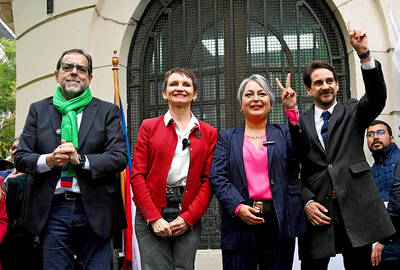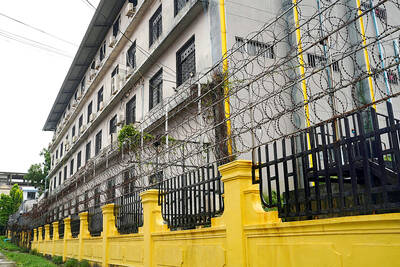Germany yesterday marked the 60th anniversary of the start of the Berlin airlift, an unprecedented undertaking that likely saved the city from falling to the Soviets and that helped mend the wounds of World War II.
Often called the first battle of the Cold War, the airlift pitted the US and the Soviets against one another for the first time and set the tone for decades to come.
Its significance wasn’t immediately apparent, however, when the operation began on June 26, 1948.
The future looked “bleak” to Berliners at the time, said Helmut Trotnow, director of Berlin’s Allied Museum.
“There was no light at the end of the tunnel, but the airlift brought this light,” Trotnow said.
“If it hadn’t been for the success of the airlift, history would have looked very different,” he said. “It really is a turning point.”
After the war, zones of western Germany were handed to Britain, France and the US to administer, while the Soviet Union was handed the east. Berlin was inside the Soviet sector, but also divided among the four powers.
In an effort to squeeze the Western powers out of Berlin, Soviet dictator Joseph Stalin in June 1948 blockaded all rail, road and ship traffic into the city.
On June 26, the US and Britain launched Operation Vittles — an unprecedented airlift that would supply some 2 million West Berliners with food and fuel for 11 months until the Soviets lifted the blockade; and several months after that in case Stalin decided to change his mind.
Neither side resorted to force — setting the tone for the Cold War — though 39 Britons, 31 Americans and at least five Germans were killed in accidents.
During the airlift, US, UK, Canadian, Australian, New Zealand and South African pilots flew some 278,000 flights to Berlin, carrying an estimated 2.3 million tonnes of food, coal, medicine and other supplies.
In one day, April 16, 1949, some 1,400 planes carried in nearly 13,000 tonnes over a 24-hour period — an average of one plane landing every 62 seconds.
In Berlin, former Luftwaffe mechanics were enlisted to help maintain aircraft, and some 19,000 Berliners — almost half women — worked around the clock for three months to build Tegel Airport, providing crucial relief for the UK Gatow and US Tempelhof airfields.
US airlift pilot Bill Voigt remembers that seeing the suffering — and determination — of the Berliners quickly erased any resentment lingering from the war.
“Regardless of how you felt about the Germans, you had to pay due homage to them for their determination to go through this one,” Voigt, now 87, said on a recent trip to Berlin.
“Most of the people in my squadron and the people I knew felt the same way — that they were putting up a gutsy fight to keep out of the hands of the Russians,” Voigt said.
On the other side, Germans — especially Berliners — were shown the human face of their former enemies, working with the occupying Western forces on a large scale for the first time against the Russians.
US airlift veteran pilot Gail Halvorsen said it was too often forgotten that the Soviets offered better rations to West Berliners willing to register with communist authorities — an offer only 20,000 took.
“If they had said ‘we can’t stand your dried eggs, we can’t eat your dried potatoes, we can’t eat your dried carrots, your dried milk’ — if they had said that, they would have been Russian and West Germany would have been Russian,” he said.

Drug lord Jose Adolfo Macias Villamar, alias “Fito,” was Ecuador’s most-wanted fugitive before his arrest on Wednesday, more than a year after he escaped prison from where he commanded the country’s leading criminal gang. The former taxi driver turned crime boss became the prime target of law enforcement early last year after escaping from a prison in the southwestern port of Guayaquil. Ecuadoran President Daniel Noboa’s government released “wanted” posters with images of his face and offered US$1 million for information leading to his capture. In a country plagued by crime, members of Fito’s gang, Los Choneros, have responded with violence, using car

Two former Chilean ministers are among four candidates competing this weekend for the presidential nomination of the left ahead of November elections dominated by rising levels of violent crime. More than 15 million voters are eligible to choose today between former minister of labor Jeannette Jara, former minister of the interior Carolina Toha and two members of parliament, Gonzalo Winter and Jaime Mulet, to represent the left against a resurgent right. The primary is open to members of the parties within Chilean President Gabriel Boric’s ruling left-wing coalition and other voters who are not affiliated with specific parties. A recent poll by the

The team behind the long-awaited Vera Rubin Observatory in Chile yesterday published their first images, revealing breathtaking views of star-forming regions as well as distant galaxies. More than two decades in the making, the giant US-funded telescope sits perched at the summit of Cerro Pachon in central Chile, where dark skies and dry air provide ideal conditions for observing the cosmos. One of the debut images is a composite of 678 exposures taken over just seven hours, capturing the Trifid Nebula and the Lagoon Nebula — both several thousand light-years from Earth — glowing in vivid pinks against orange-red backdrops. The new image

CYBERCRIME, TRAFFICKING: A ‘pattern of state failures’ allowed the billion-dollar industry to flourish, including failures to investigate human rights abuses, it said Human rights group Amnesty International yesterday accused Cambodia’s government of “deliberately ignoring” abuses by cybercrime gangs that have trafficked people from across the world, including children, into slavery at brutal scam compounds. The London-based group said in a report that it had identified 53 scam centers and dozens more suspected sites across the country, including in the Southeast Asian nation’s capital, Phnom Penh. The prison-like compounds were ringed by high fences with razor wire, guarded by armed men and staffed by trafficking victims forced to defraud people across the globe, with those inside subjected to punishments including shocks from electric batons, confinement